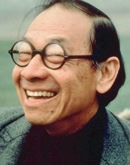
Pei - the man who let the glass pyramid grow in the Louvre
 |
"Geometry remains the basic idea of my architecture," says Pei, a living legend of architectural modernity. And it is well known from his buildings. Throughout his career, he has designed a large number of them - from industrial skyscrapers and university buildings to museums (the east wing of the National Gallery in Washington, the Mihō Museum near Kyoto, the museum in Boston, or the new wing of the Museum of History in Berlin), banks, hotels, to low-budget houses, hospitals, churches, public buildings, and an airport terminal.
Pei, who has been a citizen of the United States since 1954, also made a significant impression with the John Fitzgerald Kennedy Library in Boston, the Rock and Roll Hall of Fame and Museum in Cleveland, and the National Center for Atmospheric Research in Colorado. Although he could peacefully enjoy his well-deserved retirement, he remains active. Among his latest works is the Museum of Modern Art in Luxembourg (Mudam), which opened last July, or the Museum of Islamic Art in Doha, Qatar.
Pei received a prestigious commission between 1983 and 1989 - the expansion and modernization of the museum in the Louvre. The project was initiated by then-French President François Mitterrand. Pei's design for a large glass and steel entrance pyramid adjacent to the old buildings was shocking. However, Mitterrand liked it and advocated for it, even though more than 70 percent of French people disagreed with it. Today, the pyramid is one of the city's landmarks above the Seine. Its popularity was further enhanced by the bestseller The Da Vinci Code.
Another interesting project by Pei was the construction of the Bank of China in Hong Kong (from 1982 to 1989). The Chinese, who desired a clear visibility after the return of the colony, reached out to their famous native. Ironically, Pei's father was a former manager of this bank and a fighter against the communist regime, which now commissioned his son to design the branch of their central bank. However, Pei ultimately accepted the commission after consulting with his father, citing "satisfaction of the aspirations of the Chinese people."
Like many other of the architect's buildings, this more than seventy-story skyscraper (368 meters high) also evokes controversy. Some bank officials do not share enthusiasm for the final appearance of the building. For example, the diagonal bracing frames remind them of their names being scratched off the employee list. Experts on ancient Eastern art of feng shui, however, have "cursed" the bank building with a series of recipes to improve the entire organization's success.
Ieoh Ming Pei was born on April 26, 1917, in Canton, China. He grew up in Shanghai but left for the USA in 1935 to study architecture. He started at the University of Pennsylvania, continued at the Massachusetts Institute of Technology, and finished at Harvard, where he also served as an assistant. Pei began his career at the firm Webb & Knapp. However, in 1955 he decided to become independent and founded his firm I. M. Pei & Associates (later renamed Pei, Cobb, Freed & Partners in 1989).
In 1942, he married Chinese woman Eileen Lo, who also studied at Harvard in the USA. The Peis have four children - three sons and a daughter. Two of the sons followed in their father's professional footsteps and are engaged in design. When architect Pei is not looking into construction plans, he enjoys gardening.
The English translation is powered by AI tool. Switch to Czech to view the original text source.
0 comments
add comment
Related articles
0
28.03.2024 | The impressive glass pyramid has stood in the courtyard of the Louvre for 35 years
0
26.09.2022 | Louvre is closing earlier to reduce high energy costs
0
29.03.2019 | 30 years ago, the glass pyramid in the courtyard of the Louvre was opened
0
25.04.2017 | The American architect of Chinese origin Ieoh Ming Pei celebrates his hundredth birthday
0
25.05.2016 | The artist made the pyramid in the Louvre "disappear"
0
28.03.2014 | Twenty-five years ago, the glass pyramid in the Louvre was ceremoniously opened.











